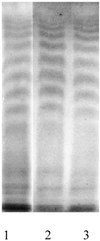Further studies of the role of cyclic beta-glucans in symbiosis. An NdvC mutant of Bradyrhizobium japonicum synthesizes cyclodecakis-(1-->3)-beta-glucosyl
- PMID: 10069844
- PMCID: PMC32087
- DOI: 10.1104/pp.119.3.1057
Further studies of the role of cyclic beta-glucans in symbiosis. An NdvC mutant of Bradyrhizobium japonicum synthesizes cyclodecakis-(1-->3)-beta-glucosyl
Abstract
The cyclic beta-(1-->3),beta-(1-->6)-D-glucan synthesis locus of Bradyrhizobium japonicum is composed of at least two genes, ndvB and ndvC. Mutation in either gene affects glucan synthesis, as well as the ability of the bacterium to establish a successful symbiotic interaction with the legume host soybean (Glycine max). B. japonicum strain AB-14 (ndvB::Tn5) does not synthesize beta-glucans, and strain AB-1 (ndvC::Tn5) synthesizes a cyclic beta-glucan lacking beta-(1-->6)-glycosidic bonds. We determined that the structure of the glucan synthesized by strain AB-1 is cyclodecakis-(1-->3)-beta-D-glucosyl, a cyclic beta-(1-->3)-linked decasaccharide in which one of the residues is substituted in the 6 position with beta-laminaribiose. Cyclodecakis-(1-->3)-beta-D-glucosyl did not suppress the fungal beta-glucan-induced plant defense response in soybean cotyledons and had much lower affinity for the putative membrane receptor protein than cyclic beta-(1-->3),beta-(1-->6)-glucans produced by wild-type B. japonicum. This is consistent with the hypothesis presented previously that the wild-type cyclic beta-glucans may function as suppressors of a host defense response.
Figures






Similar articles
-
Characterization of ndvD, the third gene involved in the synthesis of cyclic beta-(1 --> 3),(1 --> 6)-D-glucans in Bradyrhizobium japonicum.Can J Microbiol. 2002 Nov;48(11):1008-16. doi: 10.1139/w02-099. Can J Microbiol. 2002. PMID: 12556128
-
Beta-glucan synthesis in Bradyrhizobium japonicum: characterization of a new locus (ndvC) influencing beta-(1-->6) linkages.J Bacteriol. 1996 Aug;178(15):4635-42. doi: 10.1128/jb.178.15.4635-4642.1996. J Bacteriol. 1996. PMID: 8755895 Free PMC article.
-
A motility revertant of the ndvB mutant of Bradyrhizobium japonicum.Curr Microbiol. 2003 Nov;47(5):431-3. doi: 10.1007/s00284-003-4066-9. Curr Microbiol. 2003. PMID: 14669923
-
Cyclic beta-glucans of members of the family Rhizobiaceae.Microbiol Rev. 1994 Jun;58(2):145-61. doi: 10.1128/mr.58.2.145-161.1994. Microbiol Rev. 1994. PMID: 8078434 Free PMC article. Review.
-
Characterization of hepta-beta-glucoside elicitor-binding protein(s) in soybean.Biochem Soc Trans. 1994 May;22(2):408-14. doi: 10.1042/bst0220408. Biochem Soc Trans. 1994. PMID: 7958335 Review. No abstract available.
Cited by
-
Bacterial Molecular Signals in the Sinorhizobium fredii-Soybean Symbiosis.Int J Mol Sci. 2016 May 18;17(5):755. doi: 10.3390/ijms17050755. Int J Mol Sci. 2016. PMID: 27213334 Free PMC article.
-
Molecular basis of symbiotic promiscuity.Microbiol Mol Biol Rev. 2000 Mar;64(1):180-201. doi: 10.1128/MMBR.64.1.180-201.2000. Microbiol Mol Biol Rev. 2000. PMID: 10704479 Free PMC article. Review.
-
Osmoregulated periplasmic glucans of Erwinia chrysanthemi.J Bacteriol. 2001 May;183(10):3127-33. doi: 10.1128/JB.183.10.3127-3133.2001. J Bacteriol. 2001. PMID: 11325941 Free PMC article.
-
Single-cell transcriptome atlases of soybean root and mature nodule reveal new regulatory programs that control the nodulation process.Plant Commun. 2024 Aug 12;5(8):100984. doi: 10.1016/j.xplc.2024.100984. Epub 2024 Jun 6. Plant Commun. 2024. PMID: 38845198 Free PMC article.
-
Bacterial cyclic beta-(1,2)-glucan acts in systemic suppression of plant immune responses.Plant Cell. 2007 Jun;19(6):2077-89. doi: 10.1105/tpc.106.047944. Epub 2007 Jun 29. Plant Cell. 2007. PMID: 17601826 Free PMC article.
References
-
- Ahlborn B, Werner D. Inhibition of 1,3-β-glucan synthase from Glycine max and Pisum sativum by exopolysaccharides of Bradyrhizobium japonicum and Rhizobium leguminosarum. Physiol Mol Plant Pathol. 1991;39:299–307.
-
- Becker A, Pühler A. Production of exopolysaccharides. In: Spaink HP, Kondorosi A, Hooykaas JJ, editors. The Rhizobiaceae. Dordrecht, The Netherlands: Kluwer Academic Publishers; 1998. pp. 97–118.
Publication types
MeSH terms
Substances
LinkOut - more resources
Full Text Sources
Other Literature Sources

